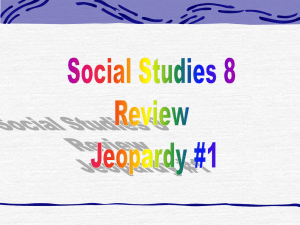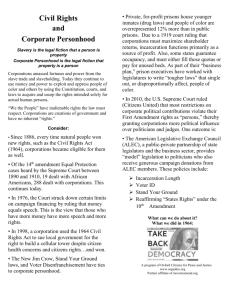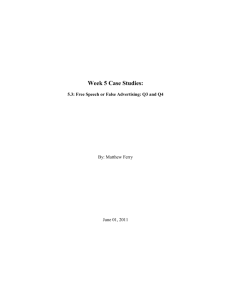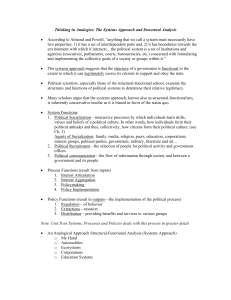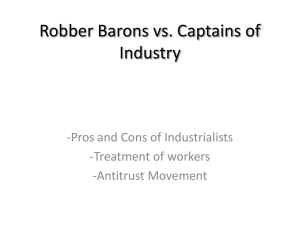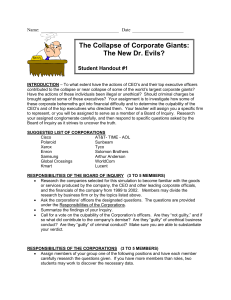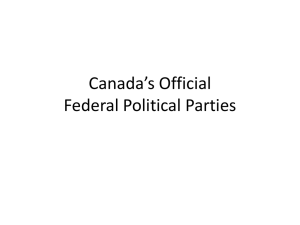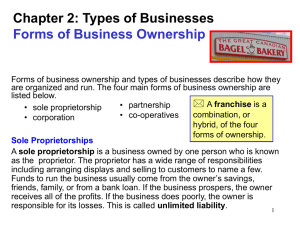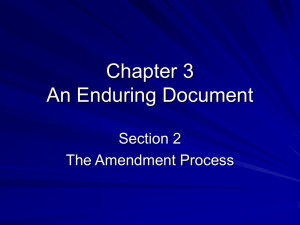Supreme Court of the United States
advertisement
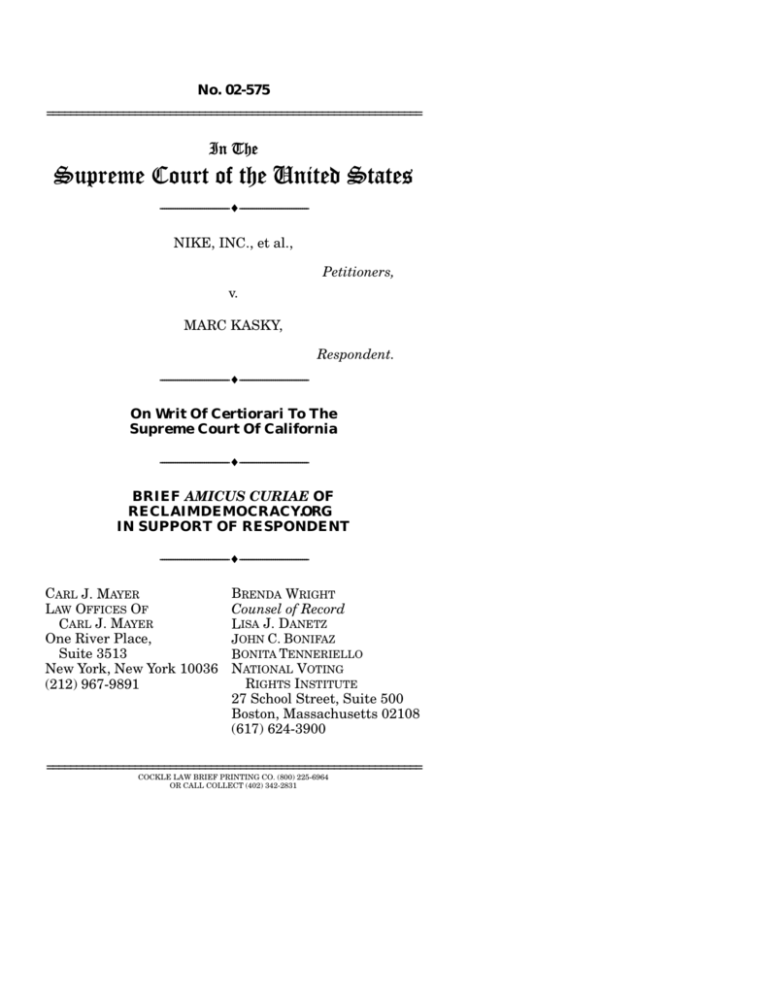
No. 02-575 ================================================================ In The Supreme Court of the United States ---------------------------------♦--------------------------------NIKE, INC., et al., Petitioners, v. MARC KASKY, Respondent. ---------------------------------♦--------------------------------On Writ Of Certiorari To The Supreme Court Of California ---------------------------------♦--------------------------------BRIEF AMICUS CURIAE OF RECLAIMDEMOCRACY.ORG IN SUPPORT OF RESPONDENT ---------------------------------♦--------------------------------CARL J. MAYER LAW OFFICES OF CARL J. MAYER One River Place, Suite 3513 New York, New York 10036 (212) 967-9891 BRENDA WRIGHT Counsel of Record LISA J. DANETZ JOHN C. BONIFAZ BONITA TENNERIELLO NATIONAL VOTING RIGHTS INSTITUTE 27 School Street, Suite 500 Boston, Massachusetts 02108 (617) 624-3900 ================================================================ COCKLE LAW BRIEF PRINTING CO. (800) 225-6964 OR CALL COLLECT (402) 342-2831 i TABLE OF CONTENTS Page Table of Authorities .................................................... ii Interest of Amicus Curiae .......................................... 1 Summary of Argument ............................................... 2 Argument .................................................................... 3 I. To Preserve The Integrity Of The “Marketplace Of Ideas,” A Business Corporation’s Factual Statements About Its Own Operations Must Be Subject To Regulation For Accuracy, Regardless Of Whether They Are Categorized As Commercial Or Non-Commercial Speech.......... 3 In The Alternative, To The Extent This Court’s Precedents Establish First Amendment Rights For Corporations Coextensive With Those Of Individuals, The Court Should Use This Case As An Opportunity To Overrule That Constitutional Interpretation......................................... 13 Conclusion .................................................................. 25 II. ii TABLE OF AUTHORITIES Page CASES Austin v. Michigan Chamber of Commerce, 494 U.S. 652 (1990) ............................................................. 7, 14, 17 Bank of Augusta v. Earle, 38 U.S. (13 Pet.) 519 (1839) .............................................................................. 16 Bank of United States v. Deveaux, 9 U.S. (5 Cranch) 61 (1809) ......................................................................... 16 Bell v. State of Maryland, 378 U.S. 226 (1964)................. 19 Central Hudson Gas & Electric Corp. v. Public Service Comm’n of NY, 447 U.S. 557 (1980) ......... 8, 9, 21 Cohen v. California, 403 U.S. 15 (1971) .............................. 8 Connecticut General Life Ins. Co. v. Johnson, 303 U.S. 77 (1938) ................................................................. 21 Consolidated Edison Co. v. Public Service Comm’n of NY, 447 U.S. 530 (1980)............................................... 8 County of San Bernardino v. Southern Pac. R. Co., 118 U.S. 417 (1886) ........................................................ 18 Dartmouth College v. Woodward, 4 Wheat. 518 (1819) .............................................................................. 16 Dodge v. Ford Motor Co., 170 N.W. 668 (Mich. 1919)........11 Federal Election Comm’n v. Massachusetts Citizens for Life, Inc., 479 U.S. 238 (1986) .................................... 7 Federal Election Comm’n v. Nat’l Right to Work Committee, 459 U.S. 197 (1982)....................................... 6 First National Bank of Boston v. Bellotti, 435 U.S. 765 (1978) ................................................................passim Gertz v. Robert Welch, Inc., 418 U.S. 323 (1974)................. 4 iii TABLE OF AUTHORITIES – Continued Page Gilbert v. Norfolk & W. Ry. Co., 171 S.E. 814 (W. Va. 1933).................................................................................11 Grosjean v. American Press Co., 297 U.S. 233 (1936)....... 17 Hague v. Committee for Industrial Organization, 307 U.S. 496 (1939) ........................................................ 20 Hale v. Henkel, 201 U.S. 43 (1906) .............................. 20, 21 Home Ins. Co. v. State of New York, 119 U.S. 129 (1886) .............................................................................. 19 Lochner v. New York, 198 U.S. 45 (1905) .......................... 22 Minneapolis & St. L. Ry. Co. v. Beckwith, 129 U.S. 26 (1889) ................................................................... 19, 20 Missouri Pac. Ry. Co. v. Mackey, 127 U.S. 205 (1888) .............................................................................. 19 New York Times v. Sullivan, 376 U.S. 254 (1964)............. 10 Northwestern Nat’l Life Ins. Co. v. Riggs, 203 U.S. 243 (1906) ................................................................. 17, 20 Pacific Gas & Electric Co. v. Public Utilities Comm’n of California, 475 U.S. 1 (1986) .... 5, 8, 9, 14, 23 Paul v. Virginia, 75 U.S. (8 Wall.) 168 (1868) ................... 16 Pembina Mining Co. v. Pennsylvania, 125 U.S. 181 (1888) .............................................................................. 16 Police Dep’t of Chicago v. Mosley, 408 U.S. 92 (1972)......... 8 Santa Clara County v. Southern Pacific Railroad Co., 118 U.S. 394 (1886) ............................... 17, 18, 19, 20 Union Pac. RR Co. v. Trustees, Inc., 329 P.2d 398 (Utah 1958) ......................................................................11 iv TABLE OF AUTHORITIES – Continued Page United States v. Morton Salt Co., 338 U.S. 632 (1950) .............................................................................. 17 United States v. White, 322 U.S. 694 (1944) ..................... 17 Virginia State Bd. of Pharmacy v. Virginia Citizens Consumer Council, Inc., 425 U.S. 748 (1976) ... 4, 6, 9, 17 West Virginia Bd. Of Education v. Barnette, 319 U.S. 624 (1943) ............................................................... 23 Wheeling Steel Corp. v. Glander, 337 U.S. 562 (1949) .............................................................................. 21 UNITED STATES CONSTITUTION Article III ............................................................................ 16 Article IV ............................................................................ 16 First Amendment ........................................................passim Fourth Amendment ............................................................ 17 Fifth Amendment ............................................................... 20 Fourteenth Amendment..............................................passim STATUTES Cal. Bus. & Prof. Code § 17200 et seq.,.............................. 10 OTHER AUTHORITIES J.C. Bancroft Davis, 118 United States Reports: Cases Adjudged in the Supreme Court at October Term 1885 and October Term 1886 (Banks & Bros. Publishers) ............................................................ 19 v TABLE OF AUTHORITIES – Continued Page T. Emerson, Toward A General Theory of the First Amendment (1966) ......................................................... 23 Daniel J.H. Greenwood, Essential Speech: Why Corporate Speech Is Not Free, 83 Iowa L. Rev. 995 (1998) ....................................................................... 14 Thom Hartmann, Unequal Protection: The Rise of Corporate Dominance and the Theft of Human Rights (2002)............................................................. 18, 19 Henderson, The Position of Foreign Corporations in American Constitutional Law, in 2 Harvard Studies In Jurisprudence 1 (1918)................................. 15 J. Hurst, The Legitimacy Of The Business Corporation In The Law Of The United States, 1780-1970 (1970) .............................................................................. 15 Carl J. Mayer, Personalizing the Impersonal: Corporations and the Bill of Rights, 41 Hastings Law Journal 577 (1990) ................................................. 15 Burt Neuborne, The First Amendment and Government Regulation of Capital Markets, 55 Brooklyn Law Review 5 (1989) ........................................ 6 1 Principles of Corp. Governance § 2.01 (1994)............11, 12 L. Tribe, Constitutional Choices (1985)............................. 22 1 INTEREST OF AMICUS CURIAE 1 Founded in 1999, ReclaimDemocracy.org is a 501(c)(3) non-profit organization that works to create a representative democracy with an actively participating public. ReclaimDemocracy.org believes that citizens’ influence in government should be a direct result of the quality of their ideas and the energy they put into promoting their positions, independent of wealth or status. It envisions citizens playing an active role in guiding the country and political agenda. In advancing this vision, ReclaimDemocracy.org works to return corporations to their intended role: business. Corporations have a legitimate role in business, but were never intended to engage in influencing public policy, elections, education or other realms of civic society. Accordingly, ReclaimDemocracy.org seeks to inspire citizens to consciously choose what role corporations should play in society and to limit corporations to that role. This case provides the Court with an opportunity to re-examine the judicial creation of constitutional rights for corporations. The privileges granted by the states via charters of incorporation are just that – privileges, not rights. Corporations do not, or should not, have “free speech” rights coextensive with those of individuals because corporations are artificial, state-created entities 1 Consents to the filing of any and all briefs amicus curiae have been granted by counsel for petitioners and respondent, as indicated on the U.S. Supreme Court docket. Pursuant to Rule 37.6, counsel for Amicus state that they authored this brief, and that this brief was not authored by counsel for any party. No person or entity other than Amicus and its counsel made a financial contribution to this brief. 2 that have no legitimate claim to a political voice. Because a reversal of the California Supreme Court’s decision would further institutionalize the power of corporate wealth to distort the political process and governance of this country, Amicus urges the Court to affirm the lower court decision. ---------------------------------♦--------------------------------SUMMARY OF ARGUMENT 1. Petitioner Nike, Inc., a business corporation, seeks First Amendment protection for false factual statements about its own operations, by arguing that those statements do not constitute commercial speech under this Court’s precedents. No purpose is served by parsing the distinction between commercial and non-commercial speech when a business corporation seeks to shield itself from responsibility for false factual statements about its own operations because, under such circumstances, both commercial and non-commercial speech may be regulated for accuracy. Because of its corporate status, Nike’s First Amendment rights stand on a different footing than those afforded to individuals, and certainly do not include First Amendment protection for the factual assertions at issue here. Moreover, Nike is in a unique position to know the truth of its statements and its communications are unlikely to be chilled by regulation of the accuracy of statements about its own operations. To insulate Nike from liability for intentionally misleading the listening public regarding its own operations, far from serving the First Amendment, would instead distort the “marketplace of ideas” that the First Amendment seeks to protect. Therefore, regardless of how Nike’s factual assertions are 3 categorized, the opinion of the California Supreme Court should be affirmed. 2. In the alternative, to the extent this Court’s precedents establish First Amendment rights for corporations coextensive with those accorded to individuals, Amicus respectfully submits that this constitutional interpretation should be overruled. The Framers of the Constitution, the Bill of Rights, and the Civil War Amendments did not intend that the Constitution should protect corporations. Indeed, the doctrine of “corporate personhood,” which has granted constitutional rights to corporations, originated with no discussion or rationale in an opinion that explicitly avoided the issue. Rather, corporations are the creatures of state law and should be subordinate, rather than superior, to the governments that create them and allow them to do business. Because the right to engage in non-commercial speech is not necessary to Nike’s existence as a business corporation, this Court should hold that Nike is not entitled to such rights and should affirm the opinion of the California Supreme Court. ---------------------------------♦--------------------------------ARGUMENT I. TO PRESERVE THE INTEGRITY OF THE “MARKETPLACE OF IDEAS,” A BUSINESS CORPORATION’S FACTUAL STATEMENTS ABOUT ITS OWN OPERATIONS MUST BE SUBJECT TO REGULATION FOR ACCURACY, REGARDLESS OF WHETHER THEY ARE CATEGORIZED AS COMMERCIAL OR NONCOMMERCIAL SPEECH. In this case, Nike, a business corporation, seeks First Amendment protection for false factual statements about 4 its own operations, by arguing that those statements do not constitute commercial speech under this Court’s precedents. Amicus submits that no purpose is served by parsing the distinction between commercial and noncommercial speech when a business corporation seeks to shield from regulation false factual statements about its own operations. Regardless of the pigeonhole into which they are placed, the factual assertions made by Nike may be regulated for their accuracy. “Untruthful speech, commercial or otherwise, has never been protected for its own sake.” Virginia State Bd. of Pharmacy v. Virginia Citizens Consumer Council, Inc., 425 U.S. 748, 771 (1976). [T]here is no constitutional value in false statements of fact. Neither the intentional lie nor the careless error materially advances society’s interest in ‘uninhibited, robust, and wide-open’ debate on public issues. . . . They belong to that category of utterances which are no essential part of any exposition of ideas, and are of such slight social value as a step to truth that any benefit that may be derived from them is clearly outweighed by the social interest in order and morality. Gertz v. Robert Welch, Inc., 418 U.S. 323, 340 (1974) (internal citations and quotations omitted). Because nothing in this Court’s precedents establishes a constitutional right for business corporations to make false statements of fact about their own operations, and regulation of the truthfulness of such statements imperils no First Amendment values, this Court should affirm the decision of the California Supreme Court regardless of how it determines the statements at issue should be categorized. Cf. Gertz, 418 U.S. 323 (finding no constitutional privilege 5 for magazine report containing defamatory falsehood, even though report regarded public issue, because individual was not public official or public figure). This conclusion is further enforced by the fact that, because of its corporate status, Nike’s First Amendment rights stand on a different footing than those afforded to individuals, and certainly do not include First Amendment protection for the statements at issue here. The speech of business corporations has been protected primarily for its presumed value to the listening public rather than because of a putative right of corporate self-expression. See, e.g., Pacific Gas & Electric Co. v. Public Utilities Comm’n of California (“PG&E”), 475 U.S. 1, 25-26 (1986) (Marshall, J., concurring) (“I do not mean to suggest that I would hold, contrary to our precedents, that the corporation’s First Amendment rights are coextensive with those of individuals. . . . In essentially all instances, the use of business property to carry out transactions with the general public will permit the State to restrict or mandate speech in order to prevent deception or otherwise protect the public’s health and welfare.”). In First National Bank of Boston v. Bellotti, 435 U.S. 765 (1978), when the Court held that corporations could not be banned from spending money to influence the outcome of a vote on a ballot initiative, the decision rested on the right of the public not to be deprived of different views within the “marketplace of ideas” rather than on any First Amendment right of business corporations to engage in such speech. See id. at 777 (“The inherent worth of the speech in terms of its capacity for informing the public does not depend on the identity of its source, whether corporation, association, union, or individual.”) (emphasis added); see also id. at 776, 777 & n.13 (reiterating multiple times that its 6 decision did not rest on any business corporation right to free speech coextensive with that of individuals). But neither Bellotti nor subsequent cases establish that a false factual statement by a corporation concerning its own business operations would obtain First Amendment protection under the rubric of its “capacity for informing the public.” Id. at 777. The “hearer-centered” basis for the protection of speech under the First Amendment is philosophically different from the traditional “speaker-centered” protection granted to individuals. See generally Burt Neuborne, The First Amendment and Government Regulation of Capital Markets, 55 Brooklyn Law Review 5, 5-40 (1989). The “right to speak” protects the right of self-expression; the “right to hear,” on the other hand, protects the interchange of ideas rather than protecting the dignity of the speaker. Id. at 15, 19. As seen in the commercial speech context, see Virginia State Bd. of Pharmacy v. Virginia Citizens Consumer Council, Inc., 425 U.S. at 770-772, the “hearer-centered” protection of speech allows more expansive regulation of speech than “speaker-centered” protection. Similarly, the “hearer-centered” protection accorded to business corporations allows more expansive regulation of their speech than does the “speaker-centered” protection afforded to individual citizens. Cf. Federal Election Comm’n v. Nat’l Right to Work Committee, 459 U.S. 197, 210-211 (1982) (restriction on solicitation by nonprofit, noncapital stock corporation for contributions to campaign committee permissible even though “governmental interest in preventing both actual corruption and the appearance of corruption . . . [was] accomplished by treating unions, corporations, and similar organizations differently from individuals.”) (emphasis added). 7 When speech is protected on behalf of the listener, regulations that safeguard the ability of the listener to evaluate the information and thereby protect the integrity of the “marketplace of ideas” are permissible. For example, in Austin v. Michigan Chamber of Commerce, 494 U.S. 652 (1990), this Court upheld a regulation of corporate expenditures for political advocacy – protected for its value in the marketplace of ideas – which the Court had already determined unconstitutional as applied to a not-for-profit political advocacy organization. Compare id. with Federal Election Comm’n v. Massachusetts Citizens for Life, Inc. (“MCFL”), 479 U.S. 238 (1986). In Austin, a business organization, organized as a corporation, challenged a statute prohibiting corporations from using corporate treasury funds for independent expenditures in support of or in opposition to candidates in elections for state office. The statute allowed corporations to make such expenditures from segregated funds used solely for political purposes. Although “expressive rights [were] implicated” by the prohibition of the use of corporate treasury funds, this Court nevertheless upheld the regulation. According to the Court, the regulation corrected for the advantages, gained by “the unique state-conferred corporate structure that facilitates the amassing of large treasuries,” that corporations have over others in advancing their ideas by addressing the “distorting effects of immense aggregations of wealth . . . that have little or no correlation to the public’s support for the corporation’s political ideas.” Austin, 494 U.S. at 660. By contrast, the Court struck down the same requirement as applied to a not-for-profit political advocacy organization because the organization, which was formed for the dissemination of political ideas, did not pose the same problem of distorting the “marketplace of political ideas.” MCFL, 479 U.S. at 257, 259. 8 Like the commercial marketplace, the “marketplace of ideas” needs accurate information to function efficiently. Within the “marketplace of ideas,” however, the countervailing First Amendment interest in individual selfexpression generally prevents regulation of the content of speech. See, e.g., Police Dep’t of Chicago v. Mosley, 408 U.S. 92, 95-96 (1972) (noting that “right to express any thought, free from government censorship” is necessary “to assure self-fulfillment for each individual” as well as “to permit the continued building of our politics and culture”); Cohen v. California, 403 U.S. 15, 24 (1971) (First Amendment places “the decision as to what views shall be voiced largely into the hands of each of us,” not only to promote a “more perfect polity,” but also “in the belief that no other approach would comport with the premise of individual dignity and choice upon which our political system rests.”). That countervailing First Amendment value has limited application to business corporations. Although the Court at times has assumed that corporations like Nike enjoy some limited “self-expressive” protection, the analyses in such cases clearly derive from the protection accorded to the listening public. See, e.g., PG&E, 475 U.S. at 15 (plurality opinion). Moreover, on the occasions when the Court has struck down regulations of the speech of business corporations, it has been to serve the integrity of the marketplace of ideas by preventing broad bans on speech concerning various public policy topics, see Central Hudson Gas & Electric Corp. v. Public Service Comm’n of NY, 447 U.S. 557 (1980) (ban on utility’s promotional advertising); Consolidated Edison Co. v. Public Service Comm’n of NY, 447 U.S. 530 (1980) (ban on bill inserts discussing any controversial issue of public policy), or has been akin to the protection of associational rights, such that a corporation 9 cannot be compelled to “speak” contrary to its views, see PG&E, 475 U.S. 1. There is no reason to grant First Amendment protection to false factual statements made by a business corporation about its own operations, however, because such statements corrupt the marketplace of ideas without serving any countervailing interest for speech protection. In Virginia State Bd. of Pharmacy v. Virginia Citizens Consumer Council, Inc., 425 U.S. 748, this Court recognized that the First Amendment provides some protection of commercial speech for similar reasons: because of the “consumer’s interest in the free flow of commercial information.” 425 U.S. at 763. Because the speech is protected for its informational value to the public, the Court recognized that regulations protecting against false or misleading information are permissible. Id. at 771-772. Virginia State Bd. of Pharmacy explained that regulations of the accuracy of speech are permissible when the speech has “greater objectivity and hardiness” than other types of speech. Id. at 771 n.24. For example, commercial speech satisfies the standard because it is “more easily verifiable by its disseminator than . . . news reporting or political commentary. . . . Also, commercial speech may be more durable than other kinds. Since advertising is the sine qua non of commercial profits, there is little likelihood of its being chilled by proper regulation and forgone entirely.” Id.; see also Central Hudson, 447 U.S. at 564 n.6 (identifying features of commercial speech that permit regulation for accuracy). This rationale for the permissibility of the regulation of truthfulness is just as applicable here – regardless of whether Nike’s speech is categorized as commercial or non-commercial. Nike is in the best position to verify the 10 accuracy of the particular speech at issue, and Nike’s speech is unlikely to be chilled because it is motivated by Nike’s own bottom line. The statements at issue, which concern Nike itself and how Nike conducts its own business, are within Nike’s control and therefore Nike is in the best position to verify them. Thus, unlike in other First Amendment contexts in which the listening public may assess inaccuracies or inconsistencies by comparison with other contradictory speech, the public here cannot adequately assess Nike’s speech because others have limited access to the facts. This important fact – that the statements were about Nike itself – and the burden of proof under California’s Unfair Competition Law, Cal. Bus. & Prof. Code § 17200 et seq., distinguish the instant case from New York Times v. Sullivan, 376 U.S. 254 (1964), and other defamation cases. In those cases, the facts at issue were not about the speaker but rather were about the plaintiff who brought the lawsuit. Moreover, the plaintiffs had only to prove the harm of the allegedly defamatory statements while the defendants, whose speech was at issue, had the burden to prove the truthfulness of the statements. This was an important factor for the Court’s imposition of a heightened intent requirement in defamation cases regarding public officials. See, e.g., id. at 279 (“Allowance of the defense of truth, with the burden of proving it on the defendant, does not mean that only false speech will be deterred.”) (emphasis added). Here, by contrast, the facts are about the speaker and it is the plaintiff – not the speaker-defendant – who has the burden of proving the falsity of the statements at issue. Thus, the procedural posture here is the mirror-image of the defamation and media cases that have come before the Court. 11 Moreover, Nike’s communications – the communications of a business corporation – like commercial speech, are not likely to be chilled by regulation for truthfulness 2 because of the presence of the profit motive. When a business corporation acts or “speaks,” it is “with a view to enhancing corporate profit and shareholder gain.” 1 Principles of Corp. Governance § 2.01 (1994); see, e.g., Dodge v. Ford Motor Co., 170 N.W. 668, 684 (Mich. 1919) (“A business corporation is organized and carried on primarily for the profit of the stockholders. The powers of the directors are to be employed for that end.”). Even when a corporation engages in activity related to the public welfare or for other reasons that are not directly businessrelated, there is generally a business-related motive for the conduct. See, e.g., Union Pac. RR Co. v. Trustees, Inc., 329 P.2d 398, 401 (Utah 1958) (concluding that corporate directors would not have made contribution to non-profit organization “if they were not confident that their company, presently and directly, would receive a quid pro quo as the resultant of good will engendered by contributions”); Gilbert v. Norfolk & W. Ry. Co., 171 S.E. 814, 815 (W. Va. 1933) (“Consistent with the general rule that a private business corporation is carried on primarily for the profit of its stockholders, . . . it has, nevertheless, been generally held that such corporations may, for the ultimate benefit of the corporation itself translated into profit, use the funds of such corporation for purposes which might 2 Although Nike makes several self-serving assertions regarding the speech that has already been chilled by this lawsuit, there is no support in the record of this case, which was dismissed on the pleadings and without any discovery, for any of these contentions. Pet. Br. at 3840. 12 appear directly to be charitable and humanitarian.”) (emphasis added); see also 1 Principles of Corp. Governance § 2.01, comment f (commenting that most corporate conduct undertaken for legal, ethical, public welfare, humanitarian, educational, or philanthropic purposes is usually “consistent with economic self-interest”). Nike’s conduct – and its factual assertions – were made with an eye toward maximizing shareholder value and therefore are unlikely to be chilled if regulated for truthfulness. Indeed, Nike admits that its conduct was motivated by the desire to maximize shareholder value. See Pet. Br. at 22 (“[V]irtually everything a company does is intended to improve its financial bottom line.”). This view is also supported by various of Nike’s amici, who state, “[B]ecause corporations are entities whose decision makers owe fiduciary duties to shareholders and owners, no responsible corporate spokesman speaks on a company’s behalf without being concerned about the effects the statements may have on corporate sales and profits.” See Brief Amici Curiae of Council of Public Relations Firms, the Arthur W. Page Society, the Public Relations Society of America, the Public Affairs Council, and the Institute for Public Relations, at 18 (emphasis added). But, contrary to the arguments of Nike and its amici, this does not make the profitoriented motivation of the speech irrelevant in determining the constitutionality of regulating false statements about a corporation’s own operations. To the contrary, it provides assurance that the kind of “chill” that sometimes prevents regulation of the accuracy of individuals’ speech is unlikely to deter protected corporate speech. Regardless of the formal “category” of Nike’s speech, Respondent’s lawsuit is permissible because it serves the First Amendment interests of the listening public by 13 protecting the integrity of the marketplace of ideas. Moreover, by establishing liability for specific asserted false factual statements, the challenged regulation is exactly tailored to ensure the accuracy of factual information asserted by a business corporation about itself in the marketplace of ideas. Accordingly, the Court should affirm the decision of the California Supreme Court. II. IN THE ALTERNATIVE, TO THE EXTENT THIS COURT’S PRECEDENTS ESTABLISH FIRST AMENDMENT RIGHTS FOR CORPORATIONS COEXTENSIVE WITH THOSE OF INDIVIDUALS, THE COURT SHOULD USE THIS CASE AS AN OPPORTUNITY TO OVERRULE THAT CONSTITUTIONAL INTERPRETATION. Contrary to the arguments advanced in Part I, Nike has assumed that this Court’s precedents grant the same level of First Amendment protection to non-commercial corporate speech as they do to speech of natural persons. In this section, Amicus argues that, to the extent this Court has interpreted the First Amendment to grant protection to business corporations coextensive with that granted to individuals, this Court should use this case to overrule that constitutional interpretation. Corporations, which are creations of state law, are not entitled to the same protections as individuals under the Bill of Rights. Corporations are artificial entities created by law for the purpose of furthering certain economic goals. A charter of incorporation is a privilege, not a right, conferred by state law that grants certain benefits to which a company would not otherwise be entitled. For example, the corporate form shields shareholders – the corporation’s owners – from liability they would otherwise 14 suffer for damages caused or debts incurred by their company. Austin, 494 U.S. at 658. Business corporations also enjoy perpetual existence and a host of other advantages to assist in their aggregation of wealth through commercial activity. Id. at 658-659. Given the benefits and advantages provided by the state, it is not unreasonable for the state to regulate business corporations to ensure that they do not use the economic benefits granted by the state for unfair advantage in other arenas of civic life. See, e.g., id. at 659-660. Specifically, it is reasonable for a state to regulate business corporations when they attempt to influence public policy and engage in public debate. Corporate speech, which by definition must be geared toward maximizing shareholder value over all else, does not express the views of citizens and therefore should not be given First Amendment protection coextensive with that provided to individual citizens. See Daniel J.H. Greenwood, Essential Speech: Why Corporate Speech Is Not Free, 83 Iowa L. Rev. 995, 1033 (1998) (“Corporations . . . are legally required to represent not a group of people but a legally defined set of interests – the interests of a fictional creature called a shareholder that has no associations, economic incentives or political views other than a desire to profit from its connection with this particular corporation.”). Simply stated, corporations are not natural persons and should not benefit directly from the protections of the First Amendment. PG&E, 475 U.S. at 35 (Rehnquist, J., dissenting) (“The insistence on treating identically for constitutional purposes entities that are demonstrably different is as great a jurisprudential sin as treating differently those entities which are the same.”). 15 Neither the framers of the Constitution and the Bill of Rights nor the framers of the Civil War Amendments intended that corporations should be afforded the protections of constitutional provisions. First, although the Framers were clearly aware of corporations – state legislatures of the era chartered banks, canal companies, railroads, toll bridge companies, and trading companies as corporations – the Constitutional provisions do not specifically include corporations. See Carl J. Mayer, Personalizing the Impersonal: Corporations and the Bill of Rights, 41 Hastings Law Journal 577, 570 n.8 (1990) (citing Henderson, The Position of Foreign Corporations in American Constitutional Law, in 2 Harvard Studies In Jurisprudence 1 (1918); J. Hurst, The Legitimacy Of The Business Corporation In The Law Of The United States, 1780-1970 (1970)). The exclusion of the term “corporation” from the express language of the Constitution is therefore significant. Case law from early in this country’s history also suggests that corporations were not intended to enjoy constitutional protections. The Court consistently relied on the “artificial entity” theory, viewing the corporation as nothing more than an artificial creature of the state, subject to government imposed limitations and restrictions. Under this view, corporations cannot assert constitutional rights against the state, their creator. See Mayer, 41 Hastings Law Journal at 580. As Chief Justice Marshall observed: A corporation is an artificial being, invisible, intangible, and existing only in contemplation of law. Being the mere creature of law, it possesses only those properties which the charter of creation confers upon it, either expressly, or as incidental 16 to its very existence. These are such as are supposed best calculated to effect the object for which it was created. Dartmouth College v. Woodward, 4 Wheat. 518, 636 (1819) (emphasis added) (quoted in Bellotti, 435 U.S. at 823 (Rehnquist, J., dissenting)). Nineteenth century case law, both before and after the enactment of the Civil War Amendments to the Constitution, recognized that the Framers did not intend the Constitution to protect corporations as it protects natural persons. Thus, the Court ruled that corporations are not “persons” or “citizens” for purposes of Article III of the Constitution, Bank of United States v. Deveaux, 9 U.S. (5 Cranch) 61, 86 (1809), and also that corporations are neither “citizens” nor persons for purposes of the Privileges and Immunities Clause of Article IV of the Constitution, Bank of Augusta v. Earle, 38 U.S. (13 Pet.) 519, 586587 (1839) (foreign corporations cannot claim rights of person under Privileges and Immunities Clause of Article IV because corporation merely “artificial being created by the charter”). Subsequent to the passage of the Fourteenth Amendment, this Court determined that corporations are not citizens for purposes of the Fourteenth Amendment Privileges and Immunities Clause, see Pembina Mining Co. v. Pennsylvania, 125 U.S. 181, 187 (1888); Paul v. Virginia, 75 U.S. (8 Wall.) 168, 177 (1868) (“[C]orporations are not citizens within its meaning. The term citizens . . . applies only to natural persons, members of the body politic, owing allegiance to the State, not to artificial persons created by the legislature, and possessing only the attributes which the legislature has prescribed.”), and that the liberty protected by the due process clause of the Fourteenth Amendment (through which the First Amendment is 17 incorporated as against the states, see Virginia State Board Of Pharmacy, 425 U.S. at 749 n.1), “is the liberty of natural, not artificial persons,” Northwestern Nat’l Life Ins. Co. v. Riggs, 203 U.S. 243, 255 (1906) (quoted in Bellotti, 435 U.S. at 822 (Rehnquist, J., dissenting)). Even now, it is clear that business corporations do not enjoy the same level of constitutional rights or protections as natural persons. Corporations, for example, do not enjoy the privilege against self-incrimination. United States v. White, 322 U.S. 694, 698 (1944). They do not enjoy the protection of the privileges and immunities clause of the Fourteenth Amendment. Grosjean v. American Press Co., 297 U.S. 233, 244 (1936). Nor do they have a right to privacy under the Fourth Amendment. United States v. Morton Salt Co., 338 U.S. 632, 652 (1950). Indeed, this Court implicitly relied on the artificial entity theory to hold that corporations do not enjoy the same First Amendment protections as individuals. See Austin, 494 U.S. at 660. Although this Court on occasion has granted constitutional rights to corporations, see, e.g. Bellotti, 435 U.S. at 822, 824-825 (Rehnquist, J., dissenting) (identifying constitutional protections enjoyed by corporations), the Court has never provided a rationale for “personifying” corporations. Indeed, the initial grant of “personhood” under the Fourteenth Amendment to corporations was, to a certain extent, a judicial mistake. Corporate personhood is generally attributed to the Court’s decision in Santa Clara County v. Southern Pacific Railroad Co., 118 U.S. 394 (1886), although the Court in that case specifically declined to address the issue. In Santa Clara County, Santa Clara County sued the Southern Pacific Railroad Company for failure to pay taxes, and the railroad presented the Court 18 with six defenses, including the argument that corporations were persons under the Equal Protection Clause of the Fourteenth Amendment. Because one of the other five defenses was successful, the Court had no occasion to decide the question of corporate personhood and specifically declined to do so: If these [other] positions are tenable, there will be no occasion to consider the grave questions of constitutional law upon which the case was determined below; for, in that event, the judgment can be affirmed upon the ground that the assessment cannot properly be the basis of a judgment against the defendant. *** As the judgment can be sustained upon this [other] ground, it is not necessary to consider any other questions raised by the pleadings and the facts found by the court. Id. at 411, 416. Indeed, in a companion case, Justice Field in a concurring opinion lamented that the “tax cases from California” did not “decide the important constitutional questions involved.” County of San Bernardino v. Southern Pac. R. Co., 118 U.S. 417, 422 (1886) (Field, J., concurring). Nevertheless, it appears that the court reporter, J.C. Bancroft Davis, included a headnote stating, “The defendant Corporations are persons within the intent of the clause in section 1 of the Fourteenth Amendment to the Constitution of the United States, which forbids a State to deny to any person within its jurisdiction the equal protection of the laws.” See Thom Hartmann, Unequal Protection: The Rise of Corporate Dominance and the Theft of 19 Human Rights 107 (2002) (quoting J.C. Bancroft Davis, 118 United States Reports: Cases Adjudged in the Supreme Court at October Term 1885 and October Term 1886 394 (Banks & Bros. Publishers). Perhaps as a result, in dicta in three cases over the subsequent three years, this Court cited Santa Clara County without explanation for the proposition that corporations are persons within the meaning of the equal protection clause of the Fourteenth 3 Amendment. See Minneapolis & St. L. Ry. Co. v. Beckwith, 129 U.S. 26, 28 (1889); Missouri Pac. Ry. Co. v. Mackey, 127 U.S. 205, 209-210 (1888); Home Ins. Co. v. State of New York, 119 U.S. 129, 133 (1886). It is notable, however, that these cases nevertheless viewed legislative classifications based in part on corporate status as permissible. Minneapolis & St. L. Ry. Co. v. Beckwith, 129 U.S. at 29; Missouri Pac. Ry. Co., 127 U.S. at 209-210; Home Ins. Co., 119 U.S. at 133. Notwithstanding the mistaken “personification” of corporations in Santa Clara, the Court’s subsequent rulings reveal that this Court has not consistently applied the implications of the corporate personhood doctrine 3 Other cases report that, during the Santa Clara argument, the Court interrupted counsel and stated, “The Court does not wish to hear argument on the question whether the provision in the Fourteenth Amendment to the Constitution, which forbids a State to deny to any person within its jurisdiction the equal protection of the laws, applies to these corporations. We are all of the opinion that it does.” Bell v. State of Maryland, 378 U.S. 226, 262 (1964); see also Hartmann, Unequal Protection: The Rise of Corporate Dominance and the Theft of Human Rights at 104. Neither the exchange that reputedly occurred during oral argument nor the Court’s alleged position on corporate personhood was reflected in the written opinion issued by the Court, which specifically avoided deciding the issue. 20 created by Santa Clara. Thus, shortly after Santa Clara, this Court ruled that corporations are “persons” for purposes of both due process and equal protection under the Fourteenth Amendment. Minneapolis & St. L. Ry. Co., 129 U.S. at 28. Nevertheless, in Northwestern National Life Insurance Co. v. Riggs, the Court ruled against a corporation because “[t]he liberty referred to in . . . [the fourteenth] amendment is the liberty of natural, not artificial persons.” 203 U.S. at 255; see also Hague v. Committee for Industrial Organization, 307 U.S. 496, 527 (1939) (Stone, J., concurring) (denying non-profit corporation First Amendment rights on basis of artificial entity theory, stating, “[T]he liberty guaranteed by the due process clause is the liberty of natural, not artificial persons.”). Likewise, the Court utilized the artificial entity theory to deny corporations Fifth Amendment privileges against self-incrimination in Hale v. Henkel, 201 U.S. 43 (1906). The Court held that the phrase “no person” in the privileges portion of the Fifth Amendment does not suggest that corporations should be included within the amendment’s protections. The majority then rendered its most expansive rendition of the artificial entity theory, drawing a sharp distinction between the individual and the corporation: The individual may stand upon his constitutional rights as a citizen. . . . His rights are such as existed by the law of the land long antecedent to the organization of the state, and can only be taken from him by due process of law, and in accordance with the Constitution. . . . Upon the other hand, the corporation is a creature of the state. . . . It receives certain special privileges and franchises, and holds them subject 21 to the laws of the state and the limitations of its charter. Its powers are limited by law. It can make no contract not authorized by its charter. Its rights to act as a corporation are only preserved to it so long as it obeys the laws of its creation. There is a reserved right in the legislature to investigate its contracts and find out whether it has exceeded its powers. It would be a strange anomaly to hold that a state, having chartered a corporation to make use of certain franchises, could not, in the exercise of its sovereignty, inquire how these franchises had been employed, and whether they had been abused, and demand the production of the corporate books and papers for that purpose. Id. at 74-75. Since the Santa Clara opinion, distinguished dissents have lamented corporate personhood. Justice Hugo Black famously remarked, “I do not believe the word ‘person’ in the Fourteenth Amendment includes corporations.” Connecticut General Life Ins. v. Johnson, 303 U.S. 77, 85 (1938) (Black, J., dissenting). Justice Douglas observed, “There was no history, logic or reason given to support that view [that corporations are persons under the Equal Protection Clause]. Nor was the result so obvious that exposition was unnecessary.” Wheeling Steel Corp. v. Glander, 337 U.S. 562, 577 (1949) (Douglas, J., dissenting). And then-Justice Rehnquist argued that “[t]he State need not permit its own creation to consume it.” Bellotti, 435 U.S. at 809 (Rehnquist, J., dissenting). Then-Justice Rehnquist also opined that granting corporations political and commercial free speech rights would bring back the discredited judicial philosophy of Lochner-style substantive due process. See Central Hudson, 22 447 U.S. at 584, 589 (Rehnquist, J., dissenting) (protesting that striking down state regulation of corporate commercial speech was nothing more than a contemporary version of Lochner v. New York, 198 U.S. 45 (1905)). At least one of Nike’s counsel has expressed agreement with this assessment. L. Tribe, Constitutional Choices 210, 214-215 (1985). In sum, the Court should return to Chief Justice Marshall’s standard for the regulation of business corporations: Corporations are entitled only to those constitutional protections that are necessary to effectuate their purpose for existence. As state creations, however, corporations should remain subject to state regulations that do not impinge on constitutional rights that are “incidental” (in the Justice Marshall sense, i.e. necessary) to their existence rather than become federalized by the grant of broad constitutional protections to artificial entities. The right to non-commercial speech is not “incidental” (in the Justice Marshall sense, i.e. necessary) to the existence of business corporations. As stated eloquently by then-Justice Rehnquist in his Bellotti dissent: It cannot be so readily concluded that the right of political expression is equally necessary to carry out the functions of a corporation organized for commercial purposes. A State grants to a business corporation the blessings of potentially perpetual life and limited liability to enhance its efficiency as an economic entity. It might reasonably be concluded that those properties, so beneficial in the economic sphere, pose special dangers in the political sphere. Furthermore, it might be argued that liberties of political expression are not at all necessary to effectuate the purposes for which States permit commercial corporations to exist. So long as the Judicial 23 Branches of the State and Federal Governments remain open to protect the corporation’s interest in its property, it has no need, though it may have the desire, to petition the political branches for similar protection. Indeed, the States might reasonably fear that the corporation would use its economic power to obtain further benefits beyond those already bestowed. Bellotti, 435 U.S. at 825-826 (Rehnquist, J., dissenting). Finally, one critical function of the First Amendment is not served in any way by granting free speech rights to business corporations: the use of communication as a means of self-expression, self-realization, and selffulfillment. Bellotti, 435 U.S. at 804 (White, J., dissenting) (citing T. Emerson, Toward A General Theory of the First Amendment 4-7 (1966); West Virginia Bd. Of Education v. Barnette, 319 U.S. 624 (1943)). Communication by a business corporation does “not represent a manifestation of individual freedom or choice,” nor does it necessarily represent the views of its shareholders, who do not share and have not invested their money for the advancement of “a common set of political or social views.” Bellotti, 435 U.S. at 805 (White, J., dissenting). “To ascribe to such artificial entities an ‘intellect’ or ‘mind’ for freedom of conscience purposes is to confuse metaphor with reality.” See PG&E, 475 U.S. at 33 (Rehnquist, J., dissenting). When speech is not the product of individual choice and emanates from a speaker to whom “individual selfexpression” is meaningless, the speech should not receive full First Amendment protection. Bellotti, 435 U.S. at 807 (White, J. dissenting). 24 Nike, a business corporation, is in the business of selling itself, its athletic apparel, and other products. Although it operates in the global marketplace, the factual assertions it made about itself and its business practices are simply not essential to its existence (except as a means to sell its products, in which case the statements at issue are commercial speech) nor were they necessary for selfexpression, inasmuch as there is no “self” of a business corporation. Nike is an entity whose existence has been legislated into reality by the State and which should remain subordinate, not superior, to state government, which grants it the privilege of existence or of doing business within the state. Because the speech at issue was the speech of a business corporation, there is no reason to allow Nike to avoid defending itself against Marc Kasky’s lawsuit. ---------------------------------♦--------------------------------- 25 CONCLUSION For the foregoing reasons, Amicus urges this Court to affirm the decision of the Supreme Court of California. Respectfully submitted, BRENDA WRIGHT Counsel of Record LISA J. DANETZ JOHN C. BONIFAZ BONITA TENNERIELLO NATIONAL VOTING RIGHTS INSTITUTE 27 School Street, Suite 500 Boston, Massachusetts 02108 Tel: (617) 624-3900 Fax: (617) 624-3911 CARL J. MAYER LAW OFFICES OF CARL J. MAYER One River Place, Suite 3513 New York, New York 10036 Tel: (212) 967-9891 Attorneys for Amicus Curiae
